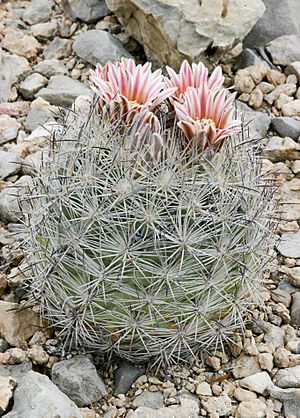Echinomastus mariposensis facts for kids
Quick facts for kids Echinomastus mariposensis |
|
|---|---|
 |
|
| Conservation status | |
| Scientific classification | |
| Kingdom: | |
| (unranked): | |
| (unranked): | |
| (unranked): | |
| Order: | |
| Family: | |
| Subfamily: | |
| Tribe: |
Cacteae
|
| Genus: |
Echinomastus
|
| Species: |
E. mariposensis
|
| Binomial name | |
| Echinomastus mariposensis Hester
|
|
| Synonyms | |
|
Neolloydia mariposensis |
|
The Echinomastus mariposensis is a very rare type of cactus. It has a few fun common names like Lloyd's fishhook cactus, golfball cactus, silver column cactus, and Mariposa cactus. This tiny cactus grows naturally in a small area. This area is on the border between Brewster County, Texas in the United States and the state of Coahuila in Mexico. Since 1979, it has been listed as a threatened species in the United States. This means it needs special protection to survive.
Contents
Where the Mariposa Cactus Lives
This small cactus can be found in about 30 different spots. Many of these spots are inside Big Bend National Park and the Black Gap Wildlife Management Area in Texas. In Mexico, it has been seen near Cuatro Ciénegas and Monclova. The cactus gets its name from the Mariposa Mine. This was a mercury mine in Texas where the cactus was first found. Scientists officially described it in 1945.
The Mariposa cactus grows in the Chihuahuan Desert. This is a dry, scrubby area. It often grows among other plants like beaked yucca, creosote, and lechuguilla. Many other cacti also grow nearby. This cactus prefers rocky, open places. It likes soil made of limestone. It does not grow in areas where the rock is gypsum. Another similar cactus, Echinomastus warnockii, grows in those gypsum areas instead. Sometimes, the Mariposa cactus grows next to the bunched cory cactus. That cactus is also a threatened species.
What the Mariposa Cactus Looks Like
This is a small cactus. It can grow up to 10 centimeters (about 4 inches) tall. It can be up to 6 centimeters (about 2.5 inches) wide. The cactus body is covered with small bumps called areoles. These are where the spines grow.
The main spines are up to 2 centimeters long. They can be white, gray, or yellow. Their tips often have a brownish or bluish color. Each areole also has many smaller spines. These are called radial spines. They are usually white or gray, sometimes with brown tips.
The flowers of this cactus are beautiful. They are white or pink. Over time, the pink flowers fade to white. They often have dark stripes down the middle. The flowers can be up to 3 centimeters long. After the flowers, a small fruit grows. It is about a centimeter long and is yellow-green. This cactus usually blooms in February and March.
Why the Mariposa Cactus is Threatened
This rare cactus faces several dangers. In the past, activities like mining and oil exploration harmed its home. Off-road vehicles and animals eating plants also caused some damage. However, the biggest threat has been poaching. This means people illegally collecting the cacti.
Cactus collectors would hire people to dig up this cactus. They would also collect other types of cacti. These plants were then stored and shipped away to be sold. Sometimes, the collected plants were thrown away or wasted. The place where the cactus was first found has been searched so much. Now, very few plants can be found there.
Luckily, the cacti inside Big Bend National Park are safer. They grow in very rough areas that are hard for collectors to reach. In 1983, the Mariposa cactus was added to Appendix 1 of CITES. This is an international agreement. It helps protect plants and animals from being illegally harvested and sold.
See also
 In Spanish: Echinomastus mariposensis para niños
In Spanish: Echinomastus mariposensis para niños


